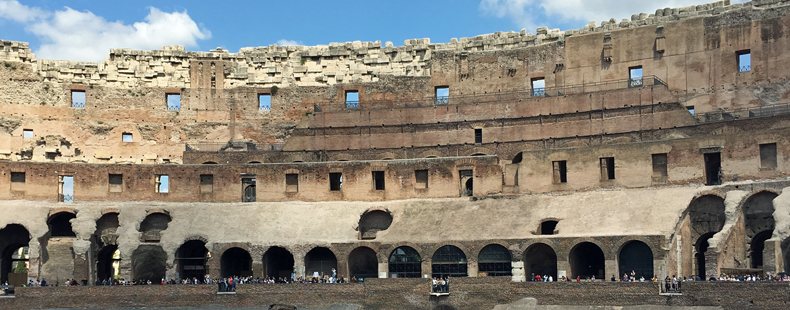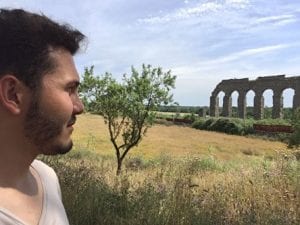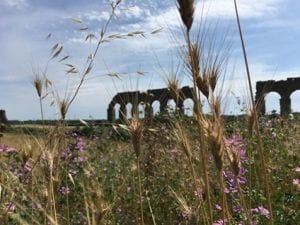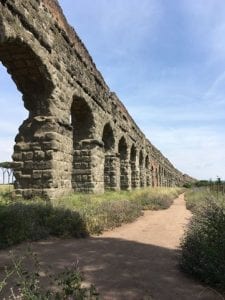This is the nineth in a series of blog posts from Whitties studying on Whitman’s Crossroads: Rome, Italy: Landscape and Cityscape in Ancient Rome program this summer with Professor Kate Shea. Juan Pablo Liendo Molina ’21 is a Politics-Environmental Studies major.
For this post, I wanted to talk about one of my highlights of the Crossroads Rome 2018, and what I consider a turning point in our group in terms of dynamics and the relationships among each other. This post is about our visit to the Park of Aqueduct, an experience filled with challenges and surprises for everyone in the group.
Visiting Rome has been an eye-opening and unique experience in terms of allowing me expand my understanding of the roots of modern engineering. Romans mastered the construction of large structures together with a purpose of making them functional and useful for their citizens. They addressed social needs in an aesthetical way, so the human intervention would merge with the environment instead of disrupting it. These practices make me believe that Romans managed to create an early concept of sustainability and environmental awareness back then. I would even say that Roman construction practices still have an important influence in our modern understanding of engineering. Furthermore, the one type of construction that made me fully understand the Roman modern influence were the Aqueducts.
Visiting the Aqueducts was an adventure for the whole group. Such journey started with a bike ride to the mountains, which in a short time turned into a marathon for many of us as struggles showed up in the way. The challenges started as few members of the group were not confident at bike riding, then heat of the sun got increasingly stronger, and finally we got lost a couple of times. All these factors led to physical and mental tiredness. As a group, we got to see a new side of everyone’s personalities and how to collaborate with the other. However, once we arrived the place, the whole experience changed, the landscape left people speechless and restored their energies back to normal. On a personal level, once we were at the place, I suddenly found myself next to my bike standing on an immense flat field which was dominated by the presence of nature and a gigantic wall of rocks. Then, several thoughts came to my mind: On a first sight, I thought of the aqueducts as a division of the field in two sides, a disruption of the natural landscape. However, when I looked at it on detail, I noticed that rather than a division, the wall was part of the landscape. Its structure composed by arches was outstanding, it connected both sides of the field, and its rocky structure allowed nature to grow around it in a harmonic relationship. Its aesthetics didn’t disrupt the landscape, but rather integrated to it while doing its function. It was amusing that such visually appealing structure in the middle of the fields also had a vital function for the whole Rome, which was to provide them with water.
Standing in front of the aqueducts was a journey across time, it meant traveling two thousand years to the past in just a second. Connecting the past and the future in the same place demonstrated to me the possibility of humans interacting with the environment and constructing long-lasting and useful structures while having a positive effect by making them part of the landscape. It helped me connect the dots and see the catharsis between functionality, aesthetics and interactions with nature. As an Environmental Studies-Politics student, Rome taught me that Politics have an immense will in the citizen’s life-quality and the sustainable development of society and natural spaces.
Looking back at the day, this experience taught me even more than just academics. It also taught me a lot about group dynamics and effort. Everyone’s personal challenges on the way to the aqueducts changed the overall mood of the group and affected each other’s experience. This situation left the group with two options, either to give up and let everyone be moody, or support each other on their struggle and push the whole group to its ultimate goal. By collaborating with the other and supporting each other, we made it to the place and got to enjoy the magnificence of the landscape.
The way how our team achieved its goal gave me a new way of understanding the Aqueducts, their structure and age. It made me understand that they are indestructible not because their big size, but because they were built by a team of people who pushed the other to the ultimate goal. It made me think in how often we easily give up in daily challenges without even trying, and in contrast how supporting each other got us that far. This experience translated to me to how real life works, and in the saying of how as separate individuals we will achieve things faster, but as a team we can go further with each other’s support. It made me think that this can reflect in our modern society and our ability to achieve a change in society.




